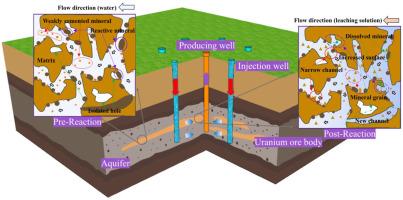Investigation on evolution characteristic of dynamic pore and reactive transport of leaching solute in uranium-bearing sandstone during in-situ alkaline leaching mining: An in-situ LF-NMR leaching experiment
IF 2.6
3区 工程技术
Q1 NUCLEAR SCIENCE & TECHNOLOGY
引用次数: 0
Abstract
In-situ uranium leaching involves complex physicochemical interactions critically influencing reservoir permeability and leaching efficiency. This study investigated microstructural changes in uranium-bearing sandstone during alkaline leaching mining through integrated column leaching experiments, real-time multi-pore geometry structure and leaching solution morphology was motored using online low-field nuclear magnetic resonance (LF-NMR), and uranium-bearing sandstone component and leaching agent was analyzed by scanning electron microscopy (SEM), X-ray diffraction (XRD) and X-ray fluorescence (XRF). The uranium-bearing sandstone predominantly comprises micropores (T2 < 2.5 ms), mesopores (2.5 ms < T2 < 100 ms), and macropores (T2 > 100 ms), with the pore system mainly composed of quartz, clinochlore, kaoline, and orthoclase. The results demonstrate that permeability reduction of 48.6 % (from 0.976 to 0.502 mD), with total pore porosity increase of 2.44 % was primarily driven by a substantial micropore reduction of 5.98 %. A significant micropore clogging was induced by precipitation of secondary minerals (CaSO4, Mg(OH)2, and silica colloids) during late-stage leaching (156–363 PV). An innovative empirical relation model for microporosity and permeability was established, and enhanced the prediction accuracy of permeability evolution. These insights reveal that micropore dynamically influence permeability evolution and uranium recovery efficiency, which benefits the technology optimization in alkaline leaching mining.

含铀砂岩原地碱浸开采过程中溶出溶质动态孔隙演化特征及反应输运研究——原位LF-NMR浸出实验
原位铀浸出涉及复杂的物理化学相互作用,对储层渗透率和浸出效率有重要影响。本研究通过综合柱式浸出实验研究了含铀砂岩在碱性浸出过程中的微观结构变化,利用在线低场核磁共振(LF-NMR)实时监测了含铀砂岩的孔隙几何结构和浸出液形态,并利用扫描电镜(SEM)、x射线衍射(XRD)和x射线荧光(XRF)对含铀砂岩组分和浸出剂进行了分析。含铀砂岩主要由微孔(T2 < 2.5 ms)、中孔(2.5 ms < T2 < 100 ms)和大孔(T2 < 100 ms)组成,孔隙系统主要由石英、斜长石、高岭土和正长石组成。结果表明:由于微孔减少了5.98%,渗透率降低了48.6%(从0.976 mD降至0.502 mD),总孔隙度增加了2.44%;在浸出后期(156-363 PV),次生矿物(CaSO4、Mg(OH)2和二氧化硅胶体)的沉淀导致了显著的微孔堵塞。创新性地建立了微孔度与渗透率的经验关系模型,提高了渗透率演化的预测精度。这些发现揭示了微孔动态影响渗透演化和铀回收率,有利于碱浸开采工艺优化。
本文章由计算机程序翻译,如有差异,请以英文原文为准。
求助全文
约1分钟内获得全文
求助全文
来源期刊

Nuclear Engineering and Technology
工程技术-核科学技术
CiteScore
4.80
自引率
7.40%
发文量
431
审稿时长
3.5 months
期刊介绍:
Nuclear Engineering and Technology (NET), an international journal of the Korean Nuclear Society (KNS), publishes peer-reviewed papers on original research, ideas and developments in all areas of the field of nuclear science and technology. NET bimonthly publishes original articles, reviews, and technical notes. The journal is listed in the Science Citation Index Expanded (SCIE) of Thomson Reuters.
NET covers all fields for peaceful utilization of nuclear energy and radiation as follows:
1) Reactor Physics
2) Thermal Hydraulics
3) Nuclear Safety
4) Nuclear I&C
5) Nuclear Physics, Fusion, and Laser Technology
6) Nuclear Fuel Cycle and Radioactive Waste Management
7) Nuclear Fuel and Reactor Materials
8) Radiation Application
9) Radiation Protection
10) Nuclear Structural Analysis and Plant Management & Maintenance
11) Nuclear Policy, Economics, and Human Resource Development
 求助内容:
求助内容: 应助结果提醒方式:
应助结果提醒方式:


